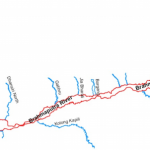What is the wind? How Thunderstorms are developed? What Science are cyclones? How are they formed? Why are they so destructive? Let us seek answers to some of these questions.
WIND
The moving air is called the wind.
AIR EXERTS PRESSURE
The air exerts pressure. It is due to this pressure that the leaves of trees, banners, or flags flutter when the wind is blowing.
HIGH SPEED WINDS ARE ACCOMPANIED BY REDUCED AIR PRESSURE
- The increased wind speed is, indeed, accompanied by a reduced air pressure.
- Air moves from the region where the air pressure is high to the region where the pressure is low. The greater the difference in pressure, the faster the air moves.
AIR EXPANDS ON HEATING
- On heating the air expands and occupies more space. When the same thing occupies more space, it becomes lighter. The warm air is, therefore, lighter than the cold air. That is the reason that the smoke goes up.
- In nature there are several situations, where warm air rises at a place. The air pressure at that place is lowered. The cold air from the surrounding areas rushes in to fill its place. This sets up convection in air.
WIND CURRENTS ARE GENERATED DUE TO UNEVEN HEATING ON THE EARTH
These situations are:
(a) Uneven heating between the equator and the poles
- Regions close to the equator get maximum heat from the Sun. The air in these regions gets warm. The warm air rises, and the cooler air from the regions in the 0–30 degrees latitude belt on either side of the equator moves in.
- These winds blow from the north and the south towards the equator. At the poles, the air is colder than that at latitudes about 60 degrees. The warm air at these latitudes rises up and the cold wind from the polar regions rushes in, to take its place. In this way, wind circulation is set up from the poles to the warmer latitudes
- The winds would have flown in the north-south direction from north to south, or from south to north. A change in direction is however, caused by the rotation of the earth.
(b) Uneven heating of land and water
- In summer, near the equator the land warms up faster and most of the time the temperature of the land is higher than that of water in the oceans. The air over the land gets heated and rises. This causes the winds to flow from the oceans towards the land. These are monsoon winds.
- In winter, the direction of the wind flow gets reversed; it flows from the land to the ocean .
- The winds from the oceans carry water and bring rain. It is a part of the water cycle.
The monsoon winds carry water and it rains.
- Clouds bring rain and give us happiness. Farmers in our country depend mainly on rains for their harvests. There are many folk songs associated with clouds and rain.
- However, it is not always a happy ending. Rains often create problems.
THUNDERSTORMS AND CYCLONES
- Thunderstorms develop in hot, humid tropical areas like India very frequently. The rising temperatures produce strong upward rising winds. These winds carry water droplets upwards, where they freeze, and fall down again. The swift movement of the falling water droplets along with the rising air create lightning and sound. It is this event that we call a thunderstorm.
How a thunderstorm becomes a cyclone
Before cloud formation, water takes up heat from the atmosphere to change into vapour. When water vapour changes back to liquid form as raindrops, this heat is released to the atmosphere. The heat released to the atmosphere warms the air around. The air tends to rise and causes a drop in pressure. More air rushes to the centre of the storm. This cycle is repeated. The chain of events ends with the formation of a very low-pressure system with very high-speed winds revolving around it. It is this weather condition that we call a cyclone. Factors like wind speed, wind direction, temperature and humidity contribute to the development of cyclones.
DESTRUCTION CAUSED BY CYCLONES
- Cyclones can be very destructive. Strong winds push water towards the shore even if the storm is hundreds of kilometres away. These are the first indications of an approaching cyclone. The water waves produced by the wind are so powerful that a person cannot overcome them.
- The low pressure in the eye lifts water surface in the centre. The rising water may be as high as 3–12 metres. It appears like a water-wall moving towards the shore. As a result, the seawater enters the low-lying coastal areas, causing severe loss of life and property. It also reduces the fertility of the soil.
- Continuous heavy rainfall may further worsen the flood situation.
- High-speed winds accompanying a cyclone can damage houses, telephones and other communication systems, trees, etc., causing tremendous loss of life and property.
Tornadoes: In our country they are not very frequent. A tornado is a dark funnel shaped cloud that reaches from the sky to the ground. Most of the tornadoes are weak. A violent tornado can travel at speeds of about 300 km/h. Tornadoes may form within cyclones.
The whole coastline of India is vulnerable to cyclones, particularly the east coast. The west coast of India is less vulnerable to cyclonic storms both in terms of intensity and frequency of the cyclones.
EFFECTIVE SAFETY MEASURE
- A cyclone forecast and warning service.
- Rapid communication of warnings to the Government agencies, the ports, fishermen, ships and to the general public.
-
Construction of cyclone shelters in the cyclone prone areas, and Administrative arrangements for moving people fast to safer places.
Action on the part of the people
-
We should not ignore the warnings issued by the meteorological department through TV, radio, or newspapers.
-
We should —
make necessary arrangements to shift the essential household goods, domestic animals and vehicles, etc. to safer places; avoid driving on roads through standing water, as floods may have damaged the roads; and keep ready the phone numbers of all emergency services like police, fire brigade, and medical centres.
Some other precautions in a cyclone hit area —
-
Should not drink water that could be contaminated. Should always store drinking water for emergencies.
-
Should not touch wet switches and fallen power lines.
-
Should not go out just for the sake of fun.
-
Should not pressurise the rescue force by making undue demands.
-
Should cooperate and help neighbours and friends.
ADVANCED TECHNOLOGY HAS HELPED
These days we are better protected. Thanks to satellites and radars, a Cyclone alert or Cyclone watch is issued 48 hours in advance of any expected storm and a Cyclone warning is issued 24 hrs in advance. The message is broadcast every hour or half hour when a cyclone is nearer the coast. Several national and international organisations cooperate to monitor the cyclone-related disasters. [Photo by GEORGE DESIPRIS from Pexels]
[Text Source : NCERT]
Read More…











